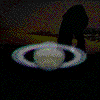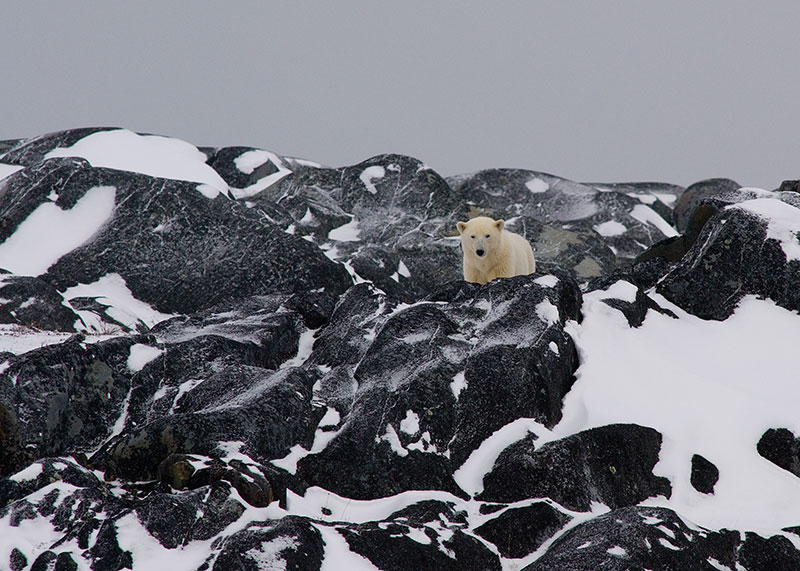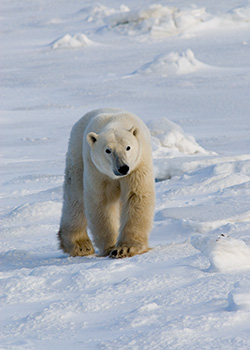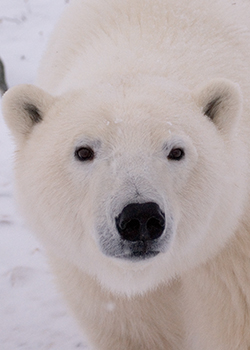 |
|
|
 |

The Rhythm of the Arctic As the nine of us pile out of the “short bus,” Dr. James Halfpenny loads his ever-present rifle and advises, “Remember, don’t stray far, as this rock formation is complex and there are plenty of sleeping (and hence hiding) places for the polar bears. We wouldn’t want to surprise one.” And so our “expedition” to the near arctic begins its second day. The sky is leaden and the shoreline of western Hudson Bay a bit foreboding. Some grease ice has formed, but the body of water (especially away from shore) is predominantly free of ice. No pack ice has yet formed. The air temperature hovers in the mid-teens. It is the first week of November at Bird Cove; before us appears a small, ancient deep-charcoal-colored granitic outcropping east of the tiny outpost town of Churchill, Manitoba. An old rusty shipwreck relic (the Ithaca) is visible in the early morning light just offshore. The scene is beautiful in its simplicity and starkness. Dr. Halfpenny (Jim, I believe he prefers) has guided small interested parties here for two decades; in the autumn and early winter for the polar bears and in the late winter (definitely feels like the dead of winter) for the viewing and photography of the northern lights. He has all the permits and possesses the knowledge to really make this more like a college course and much less like a pampered vacation. He prefers a small, intimate group of committed individuals, and sponsors his trips in concert with the Churchill Northern Studies Centre, a small research facility located out on the tundra twenty-some kilometers east of town. The Centre (once a cold war rocket range in the 1950’s) provides a base of operations, and students are accommodated in nicely heated dormitory-like rooms. Everyone is fed ridiculously well and welcomed by the very attentive international staff. Many polar bear and arctic researchers use the facility, and most of the employees are seasonal volunteers. There are classrooms, labs, a library and internet access. This is exactly my kind of “vacation,” and is an adventure I have wished to experience for decades. Our group consists mostly of people who have taken classes from Jim throughout the years, generally through the non-profit Yellowstone Association but also through Jim’s private outfit, A Naturalist’s World, centered in Gardiner, Montana just outside Yellowstone’s north gate. Included in the group are Troy (a seasonal ranger in Yellowstone), Linda (ditto), Carol and Bonnie (both from Montana, and friends through Carol’s gallery in Gardiner), Charlotte (a neighbor of Jim’s and a nature interpreter in Yellowstone), Mary (a scientist from Maryland) and my wife Cheryl (an artist) and I. Jim (an oft-published writer and a bear and tracking expert) characterizes himself as an “ursophile” (bear lover). I would characterize everyone in the group that way. The daily “gig” is to gear up (it’s cold) in the morning and drive around all day, plying the general area seeking photo ops and encounters with the Lord of the Arctic, Ursus Maritimus, the polar bear. Specifically, we are in a “short bus,” perfect because it offers just the correct number of seats so that everyone has a window to him or herself. I immediately conclude that this must be the best possible photographic platform for an eventual nexus with the great Ice Bear. We arrived yesterday on Calm Air (really!) which flies all over the Canadian arctic, dropping passengers in various remote outposts throughout the First Nation (think “native American”) province of Nunavut. First Nation (Inuit) folks inhabit this vast northern region east of the Yukon and Northwest Territories all the way up through Baffin Island and out to the Atlantic Ocean – the next stop east would be Greenland, the next stop north would be the authentic North Pole! It is a gigantic tract of land, and these tiny airplanes fly it every day, all seasons. We personally needed to refuel in Thompson, which is truly the end-of-the-road north from Winnipeg. We joke that this refueling is perhaps necessary because of the excess weight all my personal and photographic gear. Churchill, Manitoba is also serviced by rail; that trek represents a long but interesting journey across Canada’s great plains into this sub-arctic environment. “Okay, so stay close as we crest this small hill, because I have encountered polar bears right here in this rock formation,” the armed Jim additionally advises. He methodically loads and unloads his rifle every time we exit and enter the bus. The first two shells are “crackers” to scare off a pesky bear, the last two shells everyone hopes to never need or use. We are walking over some very ancient rock, some of the oldest exposed geology in the world, this formation’s age weighing in at over 2.5 billion years. The rock itself reminds me of that amazing Precambrian schist encountered when entering by river the spiritual and hallucinogenic Inner Gorge of the Grand Canyon. But here the rock is on the surface, not nestled deep down in a claustrophobic canyon – this Canadian Shield outcropping is the same formation that yielded the largest fossil trilobite ever found – the one we saw two days ago in the not-to-be-missed Museum of Man and Nature in Winnipeg. (A similar group of shallow-sea-dweller fossils are evident in Nautiloid Canyon, accessible only from the above-mentioned Inner Gorge of the Colorado River through the Grand Canyon.) The local rock intricacies also exhibit patterns and details that, along with areas of captured snow and ice, are easily reminiscent of the abstractions of Inuit art forms. We crest the ridge on foot and look out over to Hudson Bay, some 200 meters away. In between ourselves and the huge body of water (actually part of the Atlantic Ocean!) is a large, slightly yellower-than-white, object moving somewhat left to right, but also toward us. It is our second polar bear, the mighty Monarch of the North. I snap a quick photograph before Jim firmly suggests that we quickly work our way back to the bus. The bear is more than 100 meters away, but Jim notes that these large carnivores can move very quickly. Of additional interest is that we are concurrently now more than 100 meters from the bus. We all return to the vehicle, and Jim allows us to congregate near the door. Everyone prepares his or her camera for a potential encounter. The great Ice Bear appears on the ridge. It is an extraordinary sight; the dignified Titan of the High Tundra regally appearing on the horizon, standing upon one of the oldest exposed rock formations on Earth. It is a seminal moment. “Quickly, now, take your shots and then immediately board the bus,” Jim extols. And everyone does. “Bonnie, get over here and into the bus now.” It is so exciting that it is difficult to imagine an end to the encounter. But once on the bus, the experience carries on. Amazingly, the great bear continues toward us, occasionally “peeking” out through the timeless abstract rock formation, only to disappear and then reappear some meters nearer! He finally descends off the rock and draws closer to the bus. The methodical bear is apparently very curious and approaches our vehicle. Cameras beep and click but open windows must eventually be closed as the great Sultan of Snow and Ice is now leaning against the bus and looking in! To look into the eyes of this powerful animal is just wondrous. And so our adventures at this unique and fascinating location continue. We drive around on the very few (dirt) roads that exist. We encounter many additional polar bears; over 100 during our six-day, six-night stay. We also learn about the three distinct biomes of this area (coastal, tundra or taiga, and boreal forest) and visit all three. Just inland is an area of boreal forest, characterized by slightly smaller than normal spruce trees and also populated with a type of seasonally needle-dropping pine, the tamarack tree. Just north of our location the trees stop suddenly and the biomes are reduced to two, coastal and “barren-ground” tundra. But here there is much life, even during the approaching winter. We witness arctic and red fox, ptarmigan, snowy owls and even the uncommon gyrfalcon. The bears are apparently not completely alone. Soon the bears will venture out on the forming sea ice of Hudson Bay, and begin eating fat-laden ringed and bearded seals after a longtime “fast” (beginning when the bears came ashore in June or July). The newest mothers of cubs-of-the-year, having emerged from their landlocked dens in April, “fast” even longer (up to eight months), during which they continue to nurse their newborns with the richest milk on Earth! It is important that the sea ice remains a viable platform well until into the spring, and freezes as early as possible in the fall, or the bears could starve. Much climate change research and definitive observation suggests that this populations’ time on land (and hence time “fasting”) has become longer by almost a month, resulting in thinner bears, less productive females and possible eventual starvation. That is this western Hudson Bay’s polar bear group’s plight. As we learned from an evening lecture by Mr. Steven Amstrup of the USGS Alaska Science Center (after a weird bear-populated nighttime drive to town), the polar bears of the high arctic are faring much more poorly. These are the bears of Alaska and northern Russia. From maps Mr. Amstrup displayed featuring the Beaufort and Chukchi Seas and the adjacent Arctic Ocean, these polar bears are often “stranded” on receding sea ice as spring approaches. Because this very much disrupts their denning and movement patterns, it could spell extinction for the bear groups living in this area. The following dialogue is from a recent interview with Amstrup: Smithsonian Institution: “Why is global warming so bad for polar bears?” (A link to the entire interview and other important and interesting links appear at the end of this narrative.) As a point of interest, the maps used often revealed a geography looking straight down on the North Pole. Most people are not familiar with this perspective; the Earth as viewed from above the North Pole has a completely different feel. Much was learned from Mr. Amstrup’s lecture – mostly, though, it was an extremely depressing if nevertheless informative trip to town. On our “arctic expedition,” we did visit several characters offering a plethora of local flavor. One was Myrtle deMuelles, a local Metis’ [a self-proclaimed “half-breed (!) of aboriginal (non-Inuit native Canadian) and Scottish descent] who charmed us with an afternoon of nigh-feminist story-telling, drum-playing and singing – while describing her unique life in the north country and her explorations with various art forms. Some of you have “met” Myrtle in a matter of speaking; she’s the lady very upset with a marauding polar bear in the National Geographic television special “Polar Bear Alert,” filmed some time ago. We visited various “landmarks” in the frontier town of Churchill, including the veritable Inuit Museum. It is small but chock-full of wonderful authentic Inuit art. A stop at Gypsy’s Bakery is required. The ruins of a fort are out on the point, and one wind-swept afternoon we visited. It must have been something to debark from the “Nonsuch” (the British vessel that, by landing here in the middle 1600’s, essentially started the Hudson Bay Company) here, among the sub-arctic desolation that the hamlet of Churchill now represents. We observed a helicopter bear lift from the Polar Bear Compound (some might characterize it as the polar bear “jail”), where incorrigible bears are “sent” if they infiltrate the town’s city limits (red zone). There is an extensive Polar Bear Alert network that very effectively manages the inevitable random meetings between bear and human. When a bear is deemed problematic he is incarcerated until the ice freezes. He’s then airlifted to a remote location, where he can then resume his typical bear activities. This and other strategies have resulted in essentially no catastrophically negative bear-human conflicts over many years. It is hard to conclude that the management plan is anything but excellent. One difficulty has arisen after the proper closing of the town dump, once a sad reminder of negative bear-human interfacing. Once closed, the dump has been replaced by a large building where all of Churchill’s human refuse is secured until delivery to another location. The problem is, no deliveries have yet taken place. It’s been several years. There is talk of reopening the dump. A visit of interest was our late-afternoon stop at Brian Ladoon’s dog tie-down point, east of town and near the Studies Centre. The dogs tied down here now and apparently throughout the year are of an ancient breed, the Canadian Eskimo dog. Brian has “rescued” this breed over time – the tie-down area was especially fascinating because polar bears also inhabit the very same real estate. This is the location where Norbert Rosing’s interesting and bizarre photography of polar bears and dogs interacting was obtained. This happens to be not-so-rare an event. We actually saw one dog nip at the toes of a colossal polar bear. As Dr. Halfpenny pointed out to us before visiting Brian’s dog tie-down location, “I’m going to introduce you to much of what Churchill has to offer – I recommend that you just experience the moment and not at this time get caught up in any judgments. Such judgments can wait until later.” Another such activity that might solicit environmental judgments is the whole phenomena of the Tundra Buggies; those gigantic vehicles that ply the beaches of Hudson Bay with a goal of viewing and photographing polar bears and other wildlife. We experienced this for one day for an additional “monstrous” fee of over $300.00 USD per person. It is difficult to describe the activity, for it is at once both excellent and “questionable.” The vehicles are certainly destructive, but, after all, they are driving on terrain that U.S. and Canadian troop carriers and tanks drove on during the 1950’s cold war build-up. That was a bleak time for the resident polar bears as well. Presently there are only two outfits that are permitted to use such vehicles, and they are strictly regulated. The bears are far better off now too, as such regulations do not allow for even the slightest compromise of proper environmental ethic. It’s just that the mere existence of these vehicles traveling on the fragile tundra may very well be considered offensive. Regardless, the polar bear viewing from the vehicles for you and scores of your closest “associates” is honestly first-rate! As noted previously, an open window on one of these gigantic “land schooners” is a marvelous photographic platform. Dr. Halfpenny, however, is not all that enamored with this experience, and for good reason. The opportunity he offers through A Naturalist’s World is far more intimate and educational. The differences between actually walking around on the landscape and merely observing it as a spectator high above its surface are profound. Participants in Dr. Halfpenny’s “expeditions” enjoy such visceral benefits. It is true that many drivers of these behemoths (including our young operator) are very attuned to environmental concerns and do offer some naturalist’s-type commentary; nevertheless it is not an experience for the shy person looking for some quiet time out on the tundra. The proximity to the polar bears in the operators’ smallish permitted areas is outstanding, however. As Jim so aptly puts it, “Perhaps after a day on the Tundra Buggy, some folks may consider a change in their voting pattern.” Here, here. Our evenings (after the typical very hearty dinner from the staff at the Churchill Northern Studies Centre) featured short, informative lectures and discussions led by Dr. Halfpenny. One night we were also treated to a glimpse of the northern lights. Normally the autumn (before the Bay freezes) is not all that great a time for clear skies, as an icy fog (formed by the open water and a temperature differential) commonly comes ashore during the evening. One vivid night, though, a fine display occurred. You are able to view the night sky through a clear (although somewhat fogged) dome topping the Centre’s roof. On another night Jim introduced the group to some north country literature, including the colorful poetry of Robert Service. I was familiar with this material, as my friends and I have many times recited Service’s sometimes-humorous anthems to the arctic during our self-guided river trips throughout the American West. “There are strange things done in the midnight sun (from “The Cremation of Sam McGee” by Robert W. Service) There is a rhythm, a synchronicity really, to this northerly place. It is a monochromatic place in late autumn, with leaden clouds, a gray or drab green partially-frozen sea, ice in various colorless shades of white and gray and ancient geologic formations of smooth graphite and black, only occasionally “littered” with spots of colorful lichen. The coastal rock outcroppings’ various shapes and patterns clearly inspire the abstract figures of Inuit art. A typical day is weirdly lit, for at this latitude the sun runs an ever lower course from now through the dead of winter, moving more skyward only as late spring approaches. Shadows are long and the landscape has a surreal texture. Even on sunnier days a haunting twilight occurs throughout the entire day. Mostly, though, the skies are various shades of dull, hueless gray. It is the rhythm of the arctic. As members of Earth’s great sentinel bear species patiently but methodically pace the shorelines awaiting the formation of the pack ice an ominous fog approaches, with white precipitation emerging from it. The temperature plummets. A storm ensues. After the maelstrom the wind subsides and the skies clear. At night (a majority of the hours) beautiful, silent patterns of the majestic aurora borealis appear. It is the rhythm of the arctic. And what about the animal life? The local fox – white. The owl – white. The falcon – white. The bunny – white. The ground birds – white. The great Ice Bear – dirty antique white, although some individuals are actually almost pure white in color. Even the local whale is white. All of these animals have beautiful black highlights (the great bear actually has black skin) and often their eyes are haunting and deeply sunken; these eyes are commonly jet black in color. Only the human-introduced red fox demonstrates a contrasting color, very beautiful against the otherwise stark backdrop. This is a place of primordial singularity. The animals, landscape and sky are one, coalescing into a timeless pattern of seasons, migration and survival. It is the rhythm of the arctic.
Suggested resources: A Naturalist’s World Churchill Northern Studies Centre Town of Churchill official web site: arctic map of present distribution of polar bear populations: interview with Steven Amstrup: United States Geologic Survey (USGS) Polar Bear International: Myrtle’s aboriginal art web site: Nunavut Gallery, featuring Canadian aboriginal and Inuit art: Canadian Eskimo Dog (CED) Foundation: PETA’s take on Brian Ladoon’s dogs: information on the English ketch “Nonsuch:” Willis’ additional arctic content, available late January, 2008:
all text and images copyright Willis Greiner Photography, 2007 -- all rights reserved |
| Home |
About Willis Greiner |
Prints |
Inquires | |


